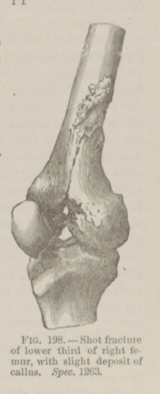Title: Hammill, J.
Source text: The Medical and Surgical History of the War of the Rebellion. (1861-65.), Part 3, Volume 2 (Washington, DC: Government Printing Office, 1883), 305.
Civil War Washington ID: med.d2e13394
TEI/XML: med.d2e13394.xml
CASE 477.—Sergeant J. Hammill, Co. D, 8th New Jersey, aged 23 years, was wounded in the right knee, at Chancellorsville, May 3, 1863. From the field he was conveyed to Potomac Creek Hospital, and thence, six weeks afterwards, to Washington, where the injured limb was amputated. Surgeon D. W. Bliss, U. S. V., who performed the operation, reported: "The wound was caused by a minié ball, which struck the external condyle of the femur and passed directly through, comminuting the condyles and lower part of the femur and opening the joint. The patient was admitted to Armory Square Hospital, June 14th. He was then suffering from profuse suppuration from the joint, and had a large abscess attended with disintegration of the tissues of the calf of the leg, in consequence of which he was in a very reduced condition. There were no symptoms of pyæmia, however. As there was no possible chance of life for the patient without an operation, it was decided to amputate, which was done on June 16th, by the circular method, at the junction of the middle and upper thirds. The soft parts were found in a very diseased condition. The patient stood the operation well and progressed favorably. Three months afterwards he was transferred to St. Elizabeth Hospital." The man was ultimately discharged from Ward Hospital, Newark, May 4, 1864, having been previously furnished with an artificial limb by E. D. Hudson, of New York City. He is a pensioner, and was paid June 4, 1878. The amputated part of the femur, together with the bones of the knee, were contributed to the Museum by the operator, and are shown in the cut (FIG. 198). The specimen shows a slight deposit of callus on the border of the fracture, and much disorganization of the articulation by suppuration.
